If there’s one thing we like better around here than old, obscure displays, it’s old, obscure displays with no documentation that need a healthy dose of reverse engineering before they can be put to use. These Plessey dot-matrix displays are a perfect example of that.
We’re not sure where [Michael] scored these displays, but they look fantastic. Each 8-pin DIP has two 5×7-matrix, high-visibility LED displays. They bear date codes from the late 80s under the part number, GPD340, but sadly, precious little data about them could be dredged up from the Interwebz. With 70 pixels and only six pins after accounting for power and ground, [Michael] figured there would be a serial protocol involved, but which pins?
He decided to brute-force the process of locating them, using a Pico to sequentially drive every combination while monitoring the current used with a current sensor. This paid off after only a few minutes, revealing that each character of the display has its own clock and data pins. The protocol is simple: pull the clock and data pins high then send 35 bits, which the display sorts out and lights the corresponding pixels. The video below shows a 12-character scrolling display in action.
Plessey made a lot of displays for military hardware, and these chunky little modules certainly have a martial air about them. Given that and the date code, these might have come from a Cold War-era bit of military hardware, like this Howitzer data display which sports another Plessey-made display.















oooh these are cute!
You can still get something similar from Broadcom these days, like the aviation-grade HCMS-2353. They’re not exactly cheap though, with 100 bucks a pop. HCMS-2901 are a little more affordable.
For new ones being made today, see Broadcom’s small serial dot-matrix LED alphanumeric- (and custom character)-capable displays, at https://www.broadcom.com/products/leds-and-displays/smart-alphanumeric-displays/serial-interface
They’re expensive, but small, available in four- and eight-character ones, daisychainable, and end-to-end stackable for longer lines, and of course vertically stackable too for multiple lines without much space between lines. The 4-character ones are the size of a 14-pin DIP.
I am not sure how to parse HELLORLD !
It’s a reference to the Usagi Electric youtube channel.
“I know that reference!” 😄
Maybe I’ll strip out the ones similar to this that I have in an old video router panel I scored in the dumpster. Was looking for buttons and such and just got sick of having all the parts and doing nothing with them. Bet they work on similar priciples.
The telly I saved from the trash had a bunch of (cheap and much bigger) 5×7 matrix LED displays , driven by some I2C expanders
Now do bad apple
Love these vintage style alphanumeric led modules. I have quite a few hp and agilent ones that I’ve designed boards to chain a bunch together into a single serial bus.
Beltronics RX-65 radar detectors used a similar type of display, I think Avago (Broadcom) made them. I reverse engineered the protocol to be able to read what the radar detector was displaying remotely using an Arduino. While I got it to work pretty reliably, there were a few glitches here and there that I never worked out before abandoning the project. It’s an older detector and there are better solutions out there now. Like getting older and slowing down on the road :)